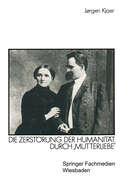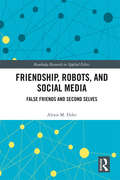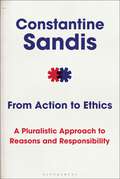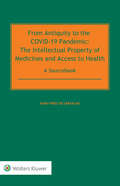- Table View
- List View
Frieden und Gerechtigkeit in der Bibel und in kirchlichen Traditionen: Politisch-ethische Herausforderungen Band 1 (Gerechter Frieden)
by Sarah Jäger Horst SchefflerDer Begriff des gerechten Friedens impliziert engen Zusammenhang von Frieden und Gerechtigkeit. Auch in biblischen Traditionen wird die Verknüpfung beider Begriffe deutlich. So umfasst der biblische Friedensbegriff Schalom stets auch Dimensionen der Gerechtigkeit. Das Zusammendenken von Frieden und Gerechtigkeit hat seine Wurzeln in der alttestamentlichen Tradition und zieht sich als roter Faden durch die kirchlichen Traditionen. Frieden und Gerechtigkeit können aber auch in einem Spannungsverhältnis stehen und zueinander in Widerspruch geraten. So kann die Umsetzung von Gerechtigkeit den Frieden gefährden (Kriege im Namen der Gerechtigkeit), und auch umgekehrt kann die Verwirklichung von Frieden als ungerecht empfunden werden.
Friedensethische Prüfsteine ziviler Konfliktbearbeitung: Politisch-ethische Herausforderungen • Band 7 (Gerechter Frieden)
Im Rahmen des Konzeptes des gerechten Friedens gilt zivile Konfliktbearbeitung als vorrangige Aufgabe. Dabei verbindet sich mit ihr zuvorderst der Modus des Umgangs mit gewaltsamen Konflikten, womit zivile Konfliktbearbeitung in erster Linie eine Kritik an der militärischen Vorgehensweise darstellt. Darüber hinaus steht er für den Prozess der Zivilisierung des Konfliktaustrags. Mit dem Begriff kommen aber auch zivile beziehungsweise zivilgesellschaftliche Akteure in den Blick. Im Fokus des Bandes steht der Versuch, vor dem Hintergrund der Breite der Handlungsbereiche, Maßnahmen und Akteure zivile Konfliktbearbeitung konkret zu fassen, zu ihrer Operationalisierung beizutragen und friedensethische Prüfsteine zu entwickeln.
Friedenssichernde Aspekte des Minderheitenschutzes in der Ära des Völkerbundes und der Vereinten Nationen in Europa (Schriftenreihe der Juristischen Fakultät der Europa-Universität Viadrina Frankfurt (Oder))
by Manfred MohrFriedrich Nietzsche: Die Zerstörung der Humanität durch ‚Mutterliebe‘ (Kulturwissenschaftliche Studien zur Deutschen Literatur)
by Jørgen KjaerFriend v. Friend: The Transformation of Friendship--and What the Law Has to Do with It
by Ethan J. LeibFriendship is one of our most important social institutions. It is the not only the salve for personal loneliness and isolation; it is the glue that binds society together. Yet for a host of reasons--longer hours at work, the Internet, suburban sprawl--many have argued that friendship is on the decline in contemporary America. In social surveys, researchers have found that Americans on average have fewer friends today than in times past. In Friend v. Friend, Ethan J. Leib takes stock of this most ancient of social institutions and its ongoing transformations, and contends that it could benefit from better and more sensitive public policies. Leib shows that the law has not kept up with changes in our society: it sanctifies traditional family structures but has no thoughtful approach to other aspects of our private lives. Leib contrasts our excessive legal sensitivity to marriage and families with the lack of legal attention to friendship, and shows why more legal attention to friendship could actually improve our public institutions and our civil society. He offers a number of practical proposals that can support new patterns of interpersonal affinity without making friendship an onerous legal burden. An elegantly written and highly original account of the changing nature of friendship, Friend v. Friend upends the conventional wisdom that law and friendship are inimical, and shows how we can strengthen both by seeing them as mutually reinforcing.
Friend v. Friend: The Transformation of Friendship--and What the Law Has to Do with It
by Ethan J. LeibFriendship is one of our most important social institutions. It is the not only the salve for personal loneliness and isolation; it is the glue that binds society together. Yet for a host of reasons--longer hours at work, the Internet, suburban sprawl--many have argued that friendship is on the decline in contemporary America. In social surveys, researchers have found that Americans on average have fewer friends today than in times past. In Friend v. Friend, Ethan J. Leib takes stock of this most ancient of social institutions and its ongoing transformations, and contends that it could benefit from better and more sensitive public policies. Leib shows that the law has not kept up with changes in our society: it sanctifies traditional family structures but has no thoughtful approach to other aspects of our private lives. Leib contrasts our excessive legal sensitivity to marriage and families with the lack of legal attention to friendship, and shows why more legal attention to friendship could actually improve our public institutions and our civil society. He offers a number of practical proposals that can support new patterns of interpersonal affinity without making friendship an onerous legal burden. An elegantly written and highly original account of the changing nature of friendship, Friend v. Friend upends the conventional wisdom that law and friendship are inimical, and shows how we can strengthen both by seeing them as mutually reinforcing.
Friends Hold All Things in Common: Tradition, Intellectual Property, and the Adages of Erasmus
by Professor Kathy EdenErasmus’ Adages-a vast collection of the proverbial wisdom of Greek and Roman antiquity-was published in 1508 and became one of the most influential works of the Renaissance. It also marked a turning point in the history of Western thinking about literary property. At once a singularly successful commercial product of the new printing industry and a repository of intellectual wealth, the Adages looks ahead to the development of copyright and back to an ancient philosophical tradition that ideas should be universally shared in the spirit of friendship.In this elegant and tightly argued book, Kathy Eden focuses on both the commitment to friendship and common property that Erasmus shares with his favorite philosophers-Pythagoras, Plato, and Christ-and the early history of private property that gradually transforms European attitudes concerning the right to copy. In the process she accounts for the peculiar shape of Erasmus’ collection of more than 3,000 proverbs and provides insightful readings of such ancient philosophical and religious thinkers as Pythagoras, Plato, Aristotle, Cicero, Iamblichus, Tertullian, Basil, Jerome, and Augustine.
Friends Not Food: The Little Book of Vegan Wisdom
by Alison GriffithsChickens, Cows, Ducks, Sheep, Pigs, Rabbits, Trout, Salmon, Prawns, Lobsters - all of the animal kingdom - are not here for us to eat, we should be looking after them.Friends Not Food is a celebration of our relationship with our animal friends and is packed with vegan sayings as well as facts about both those animals and the industries that prey on them.The perfect gift for anyone who loves animals!
Friends of the Supreme Court: Interest Groups and Judicial Decision Making
by Paul M. Collins, Jr.The U.S. Supreme Court is a public policy battleground in which organized interests attempt to etch their economic, legal, and political preferences into law through the filing of amicus curiae ("friend of the court") briefs. In Friends of the Supreme Court: Interest Groups and Judicial Decision Making, Paul M. Collins, Jr. explores how organized interests influence the justices' decision making, including how the justices vote and whether they choose to author concurrences and dissents. Collins presents theories of judicial choice derived from disciplines as diverse as law, marketing, political science, and social psychology. This theoretically rich and empirically rigorous treatment of decision-making on the nation's highest court, which represents the most comprehensive examination ever undertaken of the influence of U.S. Supreme Court amicus briefs, provides clear evidence that interest groups play a significant role in shaping the justices' choices.
Friends of the Supreme Court: Interest Groups and Judicial Decision Making
by Paul M. Collins, Jr.The U.S. Supreme Court is a public policy battleground in which organized interests attempt to etch their economic, legal, and political preferences into law through the filing of amicus curiae ("friend of the court") briefs. In Friends of the Supreme Court: Interest Groups and Judicial Decision Making, Paul M. Collins, Jr. explores how organized interests influence the justices' decision making, including how the justices vote and whether they choose to author concurrences and dissents. Collins presents theories of judicial choice derived from disciplines as diverse as law, marketing, political science, and social psychology. This theoretically rich and empirically rigorous treatment of decision-making on the nation's highest court, which represents the most comprehensive examination ever undertaken of the influence of U.S. Supreme Court amicus briefs, provides clear evidence that interest groups play a significant role in shaping the justices' choices.
Friendship and Agent-Relative Morality (Studies in Ethics)
by Troy A. JollimoreFirst Published in 2001. Morality is viewed as a demanding and unsympathetic taskmaster, and as an external, foreign, even alien force. The moral life, on such a view, is a labor not of love, but of duty. One of the guiding intuitions of this book is that this picture of morality is deeply and pervasively wrong. Morality is not an external or alien force and is not at all disconnected from the agent’s values, or from her good. Indeed, what is morally required of an agent will/depend a great deal on, and will thus reflect, that agent’s values, commitments, and relationships.
Friendship and Agent-Relative Morality (Studies in Ethics)
by Troy A. JollimoreFirst Published in 2001. Morality is viewed as a demanding and unsympathetic taskmaster, and as an external, foreign, even alien force. The moral life, on such a view, is a labor not of love, but of duty. One of the guiding intuitions of this book is that this picture of morality is deeply and pervasively wrong. Morality is not an external or alien force and is not at all disconnected from the agent’s values, or from her good. Indeed, what is morally required of an agent will/depend a great deal on, and will thus reflect, that agent’s values, commitments, and relationships.
Friendship, Robots, and Social Media: False Friends and Second Selves (Routledge Research in Applied Ethics)
by Alexis M. ElderVarious emerging technologies, from social robotics to social media, appeal to our desire for social interactions, while avoiding some of the risks and costs of face-to-face human interaction. But can they offer us real friendship? In this book, Alexis Elder outlines a theory of friendship drawing on Aristotle and contemporary work on social ontology, and then uses it to evaluate the real value of social robotics and emerging social technologies. In the first part of the book Elder develops a robust and rigorous ontology of friendship: what it is, how it functions, what harms it, and how it relates to familiar ethical and philosophical questions about character, value, and well-being. In Part II she applies this ontology to emerging trends in social robotics and human-robot interaction, including robotic companions for lonely seniors, therapeutic robots used to teach social skills to children on the autism spectrum, and companionate robots currently being developed for consumer markets. Elder articulates the moral hazards presented by these robots, while at the same time acknowledging their real and measurable benefits. In the final section she shifts her focus to connections between real people, especially those enabled by social media. Arguing against critics who have charged that these new communication technologies are weakening our social connections, Elder explores ways in which text messaging, video chats, Facebook, and Snapchat are enabling us to develop, sustain, and enrich our friendship in new and meaningful ways.
Friendship, Robots, and Social Media: False Friends and Second Selves (Routledge Research in Applied Ethics)
by Alexis M. ElderVarious emerging technologies, from social robotics to social media, appeal to our desire for social interactions, while avoiding some of the risks and costs of face-to-face human interaction. But can they offer us real friendship? In this book, Alexis Elder outlines a theory of friendship drawing on Aristotle and contemporary work on social ontology, and then uses it to evaluate the real value of social robotics and emerging social technologies. In the first part of the book Elder develops a robust and rigorous ontology of friendship: what it is, how it functions, what harms it, and how it relates to familiar ethical and philosophical questions about character, value, and well-being. In Part II she applies this ontology to emerging trends in social robotics and human-robot interaction, including robotic companions for lonely seniors, therapeutic robots used to teach social skills to children on the autism spectrum, and companionate robots currently being developed for consumer markets. Elder articulates the moral hazards presented by these robots, while at the same time acknowledging their real and measurable benefits. In the final section she shifts her focus to connections between real people, especially those enabled by social media. Arguing against critics who have charged that these new communication technologies are weakening our social connections, Elder explores ways in which text messaging, video chats, Facebook, and Snapchat are enabling us to develop, sustain, and enrich our friendship in new and meaningful ways.
A Frightening Love: Recasting the Problem of Evil
by Andrew GleesonA Frightening Love radically rethinks God and evil. It rejects theodicy and its impersonal conception of reason and morality. Faith survives evil through a miraculous love that resists philosophical rationalization. Authors criticised include Alvin Plantinga, Richard Swinburne, Marilyn McCord Adams, Peter van Inwagen, John Haldane, William Hasker.
Friston on Costs
by Mark FristonFriston on Costs is the third edition of the acclaimed authority on civil costs law, previously entitled Civil Costs: Law and Practice. Separated into sixteen parts, this substantial text covers all aspects of the law of civil costs from the formation of contracts of retainers, funding, costs budgeting, and orders for and about costs, all the way through to the assessment of costs and beyond. The third edition has been extensively updated to take into account changes in the law following the Jackson reforms. It also includes discussions on the Consumer Rights Act 2015, alternative dispute resolution, alternative methods of pricing, and legal project management. Friston features thorough cross referencing throughout, enabling the user to easily locate answers to even the most complex of costs issues. It is an invaluable resource for costs judges and practitioners alike.
Friston on Costs
by Mark FristonFriston on Costs is the third edition of the acclaimed authority on civil costs law, previously entitled Civil Costs: Law and Practice. Separated into sixteen parts, this substantial text covers all aspects of the law of civil costs from the formation of contracts of retainers, funding, costs budgeting, and orders for and about costs, all the way through to the assessment of costs and beyond. The third edition has been extensively updated to take into account changes in the law following the Jackson reforms. It also includes discussions on the Consumer Rights Act 2015, alternative dispute resolution, alternative methods of pricing, and legal project management. Friston features thorough cross referencing throughout, enabling the user to easily locate answers to even the most complex of costs issues. It is an invaluable resource for costs judges and practitioners alike.
Friston on Costs (book and digital pack)
by Mark Friston and Hailsham ChambersFriston on Costs is the acclaimed and often-cited authority on the law of costs. Separated into sixteen well-defined and easily navigable parts, this substantial and encyclopaedic text covers all aspects of the law of civil costs from funding and contracts of retainers, all the way through to the assessment of costs (both between opposing parties and between solicitor and client). The fourth edition has been updated to take into account the considerable number of authorities on this difficult and technical topic. Areas of interest to specialists have also been expanded upon, such as the recoverability of the costs of inquests, the costs of solicitors who act in their own cause, and disclosure of litigation funding. Friston features thorough cross-referencing throughout, enabling the user to easily locate answers to even the most complex of costs issues. It is an invaluable resource for costs judges, academics, and practitioners alike. Companion website: www.oup.com/friston
Friston on Costs (book and digital pack)
Friston on Costs is the acclaimed and often-cited authority on the law of costs. Separated into sixteen well-defined and easily navigable parts, this substantial and encyclopaedic text covers all aspects of the law of civil costs from funding and contracts of retainers, all the way through to the assessment of costs (both between opposing parties and between solicitor and client). The fourth edition has been updated to take into account the considerable number of authorities on this difficult and technical topic. Areas of interest to specialists have also been expanded upon, such as the recoverability of the costs of inquests, the costs of solicitors who act in their own cause, and disclosure of litigation funding. Friston features thorough cross-referencing throughout, enabling the user to easily locate answers to even the most complex of costs issues. It is an invaluable resource for costs judges, academics, and practitioners alike. Companion website: www.oup.com/friston
From '9-11' to the 'Iraq War 2003': International Law in an Age of Complexity
by Dominic McGoldrickThis book is a tale of two towers,two wars and two visions. The two towers are those of the World Trade Center in New York, destroyed by a terrorist attack on 11 September 2001. The two wars are the War Against Terrorism and the War on Iraq. The two visions are of the international legal and political order for the twenty-first century. The issues involved in the War Against Terrorism and the War on Iraq are of fundamental importance because they may define the shape of international order for the twenty-first century.The book has a number of themes. First, it considers the principal international law and international order issues involved in the War Against Terrorism and in the War on Iraq in 2003. Specific attention is given to the application of international humanitarian and international human rights law in the wars. Secondly it asks how the international debate on the Iraq War was conducted and why? Finally it questions whether the post-1945 system of international laws and organizations is capable of surviving, and in what form? Chapter one outlines how the relationship between war and the international legal order has evolved and introduces the idea of 'complexity theory' as a framework for understanding the events and issues considered in this book. Chapter two considers the pattern of events from the attacks on the US on 9-11 to the Iraq War 2003. Chapter three addresses the issues of law and morality involved in the War Against Terrorism and the War on Iraq. Chapter four focuses on the moral and legal debate around the War on Iraq and chapter five considers the systemic consequences for international law doctrine and practice, giving particular weight to US policy and approaches and how other states have responded to them. Chapter six appraises the post-war situation in Iraq in terms of political and economic organisation and human rights. It also assesses the consequences of the status of post-war Iraq for the wider region. Chapter seven concludes the book by examining the possible implications of the War Against Terrorism and the War on Iraq for world order in the twenty-first century.
From a Rational Point of View: How We Represent Subjective Perspectives in Practical Discourse
by Tim HenningWhen discussing normative reasons, oughts, requirements of rationality, motivating reasons, and so on, we often have to use verbs like "believe" and "want" to capture a relevant subject's perspective. According to the received view about sentences involving these verbs, what they do is describe the subject's mental states. Many puzzles concerning normative discourse have to do with the role that mental states consequently appear to play in normative discourse. Tim Henning uses tools from semantics and the philosophy of language to develop an alternative account of sentences involving these verbs. According to this view, which is called parentheticalism, we very commonly use these verbs in a parenthetical sense. These verbs themselves express backgrounded side-remarks on the contents they embed, and these latter, embedded contents constitute the at-issue contents. This means that instead of speaking about the subject's mental states, we often use sentences involving "believe" and "want" to speak about the world from her point of view. Henning makes this notion precise, and uses it to solve various puzzles concerning normative discourse. The final result is a new, unified understanding of normative discourse, which gets by without postulating conceptual breaks between objective and subjective normative reasons, or normative reasons and rationality, or indeed between the reasons we ascribe to an agent and the reasons she herself can be expected to cite. Instead of being connected to either subjective mental states or objective facts, all of these normative statuses are can be adequately articulated by citing worldly considerations from a subject's point of view.
From a Rational Point of View: How We Represent Subjective Perspectives in Practical Discourse
by Tim HenningWhen discussing normative reasons, oughts, requirements of rationality, motivating reasons, and so on, we often have to use verbs like "believe" and "want" to capture a relevant subject's perspective. According to the received view about sentences involving these verbs, what they do is describe the subject's mental states. Many puzzles concerning normative discourse have to do with the role that mental states consequently appear to play in normative discourse. Tim Henning uses tools from semantics and the philosophy of language to develop an alternative account of sentences involving these verbs. According to this view, which is called parentheticalism, we very commonly use these verbs in a parenthetical sense. These verbs themselves express backgrounded side-remarks on the contents they embed, and these latter, embedded contents constitute the at-issue contents. This means that instead of speaking about the subject's mental states, we often use sentences involving "believe" and "want" to speak about the world from her point of view. Henning makes this notion precise, and uses it to solve various puzzles concerning normative discourse. The final result is a new, unified understanding of normative discourse, which gets by without postulating conceptual breaks between objective and subjective normative reasons, or normative reasons and rationality, or indeed between the reasons we ascribe to an agent and the reasons she herself can be expected to cite. Instead of being connected to either subjective mental states or objective facts, all of these normative statuses are can be adequately articulated by citing worldly considerations from a subject's point of view.
From Action to Ethics: A Pluralistic Approach to Reasons and Responsibility
by Professor Constantine SandisOver the course of the last 15 years, Constantine Sandis has advanced our understanding of the role that action plays in shaping our moral thought. In this collection of his best essays in the philosophy of action, Sandis brings together updated versions of his writings, accompanied by a new introduction. Read collectively they demonstrate the breadth of his interests and ability to relate to broader issues within the culture, connecting debates in philosophical psychology about motivation, negligence, and moral responsibility with Greek tragedy, social psychology and literature. Along this path from action to ethics, Sandis engages with Hegel, Wittgenstein, Anscombe, Ricoeur, Davidson, and Dretske, together with contemporary authors such as Jennifer Hornsby and Jonathan Dancy. As he responds to each thinker and theme, he develops his own philosophical position, the key thesis of which is that philosophy of action without ethics is empty, ethics without philosophy of action is blind.
From Action to Ethics: A Pluralistic Approach to Reasons and Responsibility
by Professor Constantine SandisOver the course of the last 15 years, Constantine Sandis has advanced our understanding of the role that action plays in shaping our moral thought. In this collection of his best essays in the philosophy of action, Sandis brings together updated versions of his writings, accompanied by a new introduction. Read collectively they demonstrate the breadth of his interests and ability to relate to broader issues within the culture, connecting debates in philosophical psychology about motivation, negligence, and moral responsibility with Greek tragedy, social psychology and literature. Along this path from action to ethics, Sandis engages with Hegel, Wittgenstein, Anscombe, Ricoeur, Davidson, and Dretske, together with contemporary authors such as Jennifer Hornsby and Jonathan Dancy. As he responds to each thinker and theme, he develops his own philosophical position, the key thesis of which is that philosophy of action without ethics is empty, ethics without philosophy of action is blind.
From Antiquity to the COVID-19 Pandemic: The Intellectual Property of Medicines and Access to Health - A Sourcebook
by Nuno Pires de CarvalhoThe COVID-19 pandemic has magnified the tensions inherent in the interface of proprietary medicines and the strong reaction of society at large in respect of pharmaceutical inventors and rights holders. As this comprehensive collection of sources shows, these tensions have persisted since ancient times. The sources—along with headnotes and a deeply informed preamble—clearly illustrate how society has constructed intellectual property in association with medicines to adapt it to the needs of entrepreneurship and free trade, and, at the same time, accommodating it to the imperatives of public health. Revealing two major lines of tension—trademarks versus generic designations and patents versus trade secrets—the texts deal with such aspects of the special intellectual property of medicines and access to health as the following: the question of whether inventions that are crucially important to save lives should be left in private hands to be exploited with a view on profitability; prohibiting the use of trademarks to designate certain medicines; loss of distinctiveness of some well-known pharmaceutical trademarks; sanitary authorities as a sort of a parallel trademark and patent office; the requirement of higher distinctiveness for pharmaceutical trademarks—the so-called duty of greater care; use of secrecy to secure private interests in pharmaceutical inventions; granting prizes and awards to inventors instead of acknowledging private proprietary rights in pharmaceuticals; and the protection of inventions in times of epidemics. The sources are structured in two chapters (business identifiers—trademarks, geographical indications, shop signs—and appropriation of knowledge—patents, trade secrets) to permit an easy understanding of the enchainment of important moments that have contributed to give intellectual property for medicines its special configuration. The selection of sources (more than 200) underlines the struggle of creative entrepreneurs in the pharmaceutical field to obtain a living from their trade and all the contradictions to which it gives rise, as well as approaches that governments have adopted to deal with its tensions. Practitioners in intellectual property law and healthcare law, magistrates, medical professionals, and academics will have a better sense of how the imperatives of public health have designed and continue designing norms and principles of intellectual property especially adapted to the social goals it serves.
















